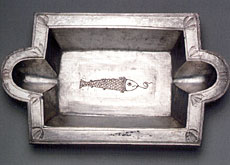Archaeologists cross the Rubigen

“Crossing the Rubicon” is widely believed to refer to the moment when Julius Caesar and his army crossed the stream separating Gaul from Italy – a move which meant civil war.
Now Swiss archaeologists are challenging that theory.
They say the phrase refers to a critical juncture in Caesar’s campaign against the Helvetic tribes near Rubigen in 51BC.
“This is bound to be controversial. But the facts are overwhelming,” said project leader Felix auf der Mauer, who has been digging at Rubigen near Bern since 1997.
For almost 20 years, auf der Mauer and his colleagues at Bern University have been shedding new light on Caesar’s campaigns in Switzerland.
Their findings are published in this month’s edition of the historical journal, “Alpenraum”.
Trade route
Rubigen today is a prosperous village, which lies in the shadow of Belp International Airport, about 15 kilometres south of the capital, Bern.
Some 2,000 years ago, it was a thriving city and headquarters of the warlike Rubigensis tribe.
It is no coincidence that the airport was built here. Since antiquity, Belp has sat astride the trade route which links the Iberian peninsula with Arabia.
By the autumn of 51BC, Caesar had pacified most of the Helvetic tribes and was keen to return to Rome to confront his rivals.
But he was aware that unless he subdued the Rubigensis, the whole territory might erupt in rebellion.
His troops were weary and mutinous, and he banked on a rapid campaign, using a deceptive ploy which had served him well in Gaul just a year earlier.
War chariot
The Roman general split his army keeping the main body of troops concealed in woodland south of the city.
And when the Rubigensis sallied forth against his remaining legions, Caesar trapped and destroyed their army in a classic pincer movement.
According to chronicles, the Rubigensis wore few clothes, preferring to paint their bodies red and white – colours which would later be adopted for the Swiss flag.
Archaeology is prohibited near the airport’s runway but even today farmers occasionally unearth a war chariot or life-size statue of a Roman deity outside the perimeter.
Rich prize
“Everything fits,” auf der Mauer told swissinfo. “The timing is right, the archaeological evidence is irrefutable and we know that in Roman slang, the word ‘to cross’ was the same as ‘to double-cross’ or to ‘cheat’.”
So how did one of the most celebrated phrases in history get mixed up?
Auf der Mauer thinks he has the answer: “In later years, Caesar had a lot of enemies. They had to find a way of justifying their actions.”
“So they took a well-known incident – the cheating of the Rubigensis – which would have been familiar to every schoolboy in antiquity and merged it with a minor episode – the crossing of the Rubicon – which, after all, was little more than a stream.”
swissinfo, Vincent Landon
Archaeologists have shed new light on Caesar’s campaigns in Switzerland.
They say that his deception and defeat of a powerful tribe at Rubigen led to the phrase, “crossing the Rubigen”.
Rubigen is 15 kilometres south of the capital Bern.
Historians traditionally believe that “crossing the Rubicon” refers to another incident in Caesar’s career.

In compliance with the JTI standards
More: SWI swissinfo.ch certified by the Journalism Trust Initiative

You can find an overview of ongoing debates with our journalists here . Please join us!
If you want to start a conversation about a topic raised in this article or want to report factual errors, email us at english@swissinfo.ch.